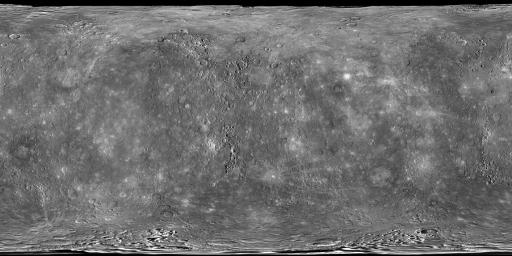
|
A World View
- Click the image above for a larger view
- Full-Res JPEG (3060 x 1530) (1.1 MB)
- Full-Res TIFF (3060 x 1530) (4.7 MB)
Caption:
As of last month, all of the data acquired during MESSENGER's one-year primary mission are available at NASA's Planetary Data System (PDS) . The mosaic above is a global view of Mercury assembled from images in the PDS and covers >99.9% of the surface. Download larger versions of this mosaic, at resolutions up to 250 m/pixel, from this global mosaics webpage . Or, explore this mosaic interactively using the QuickMap tool! It's also interesting to remember that prior to the MESSENGER mission, only 45% of Mercury's surface had been seen by spacecraft !
Date Released:
September 7, 2012
Instrument:
Mercury Dual Imaging System (MDIS)
Center Latitude:
0°
Center Longitude:
0° E
Resolution:
5 kilometers/pixel
Scale:
Mercury's diameter is 4880 kilometers (3030 miles).
Map Projection:
simple cylindrical
Background Info:
The MESSENGER spacecraft is the first ever to orbit the planet Mercury, and the spacecraft's seven scientific instruments and radio science investigation are unraveling the history and evolution of the Solar System's innermost planet. Visit the Why Mercury? section of this website to learn more about the key science questions that the MESSENGER mission is addressing. During the one-year primary mission, MDIS acquired 88,746 images and extensive other data sets. MESSENGER is now in a year-long extended mission, during which plans call for the acquisition of more than 80,000 additional images to support MESSENGER's science goals.
These images are from MESSENGER, a NASA Discovery mission to conduct the first orbital study of the innermost planet, Mercury. For information regarding the use of images, see the MESSENGER image use policy .
Cataloging Keywords:
| Name | Value | Additional Values |
|---|---|---|
| Target | Mercury | |
| System | ||
| Target Type | Planet | |
| Mission | MESSENGER | |
| Instrument Host | MESSENGER | |
| Host Type | Orbiter | |
| Instrument | Mercury Dual Imaging System (MDIS) | |
| Detector | ||
| Extra Keywords | Grayscale, Map, Radio | |
| Acquisition Date | ||
| Release Date | 2012-10-29 | |
| Date in Caption | 2012-09-07 | |
| Image Credit | NASA/Johns Hopkins University Applied Physics Laboratory/Carnegie Institution of Washington | |
| Source | photojournal.jpl.nasa.gov/catalog/PIA16298 | |
| Identifier | PIA16298 | |
